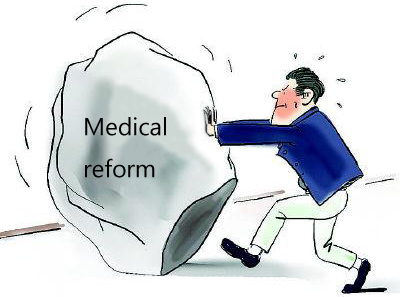(Ecns.cn) – Deterioration of doctor-patient relationships has become one of the year's focal events in China, as tensions continue to mount over the intensifying credibility crisis in the country's medical system.
Many Chinese doctors mockingly refer to themselves as warriors in a battleground, saying they could wind up involved in violent disputes any day at work.
Limited government support for healthcare expenses is a major cause, a problem that forces hospitals to rely on user fees and leaves doctors bent on earning profits by any possible means.
In 2010, China only spent 4.3% of its GDP on healthcare, less than the lowest ratio of 5% advised by the World Health Organization (WHO), reported China Weekly. In the same year, according to the latest WHO statistics, the figure was 8.1% in Japan, 10.4% in Germany, 11.1% in France, and 16.1% in the U.S.
As early as January 2011, Dr. Zhong Nanshan, known as one of the first Chinese scientists to identify the SARS virus, raised the question of whether the government could eventually link investment in healthcare to the country's GDP in a dynamic way. But as of this report, no effective policy has been made to bring about such a change.
The long-expected 5%
Since the 1980s, China's healthcare has undergone a drastic makeover into a more market-oriented system. In 1985, the first medical reform was launched in the country; its main tasks were to mobilize the initiatives of hospitals by providing sufficient healthcare resources, and resolve the difficulty in seeing doctors, getting surgery and hospitalization.
In 1997, China started its second medical reform, which aimed to transform the healthcare system into a public welfare undertaking with government financial support. The reform stipulated that the government would spend about 5% of its GDP on healthcare by the end of the 20th century, and hopefully increase the ratio steadily in the next century, according to China Weekly.
The goal was half-achieved, with the government's total expenditure on healthcare reaching 5% in 1999 and 5.7% in 2000. But later, to everyone's surprise, it shrank drastically.
In 2009, the third medical reform was seen as a new hope in China; however, the GDP goal was never mentioned. When Yin Dakui, former Minister of Health, was asked about the issue, he said only that it was hard to achieve, but did not reveal the reason.
Why not invest in healthcare?
The third medical reform has been thoroughly discussed since 2006, and the government has been very cautious about every detail – it took three years before the formal release of the reform roadmap, noted Liu Guo'en, a health policy researcher with Peking University.
As part of the reform, the government plans to invest 850 billion yuan ($134 billion) to provide fair, affordable and quality healthcare services for the public. Major reform measures include expanding the healthcare insurance umbrella, public hospital reform, establishing an essential drug system and improving health equality, according to Xinhua.
However, Liu said the Chinese government's budgetary support only amounts to about 25% of the total expenditure on the country's medical treatment and public health.
This ratio ranks as one of the lowest in the world, even lower than many underdeveloped African countries, according to Xiao Qinglun, a Harvard professor.
In Thailand, the figure is higher than 50% every year. In the U.S., it is about 46% on average, without taking into consideration the policy of tax deductions and exemptions.
Liu Guo'en said it may or may not be a reasonable quantitative measure of how much a government should invest in its healthcare, but the ratio nevertheless reflects the extent to which the government is taking the issue seriously.
Though the amount of money is increasing, the ratio remains nearly the same, always at about 15%, whether it was 458.7 billion yuan ($72 billion) in 2000 or 1.1 trillion yuan ($172.9 billion) in 2007, said Yin Dakui.
This has much to do with the current medical system, which still cannot distribute medical resources in a balanced way across the nation, according to the Beijing News.
Medical services at state expense a chronic ill
Since the reform and opening up over three decades ago, medical resources have achieved substantial growth, but most of them are still concentrated in major cities and on government staff, said Liu Guo'en. For example, civil servants get medical services at the state's expense, which is also part of the government's budget for healthcare.
As healthcare reform deepens, the government must continue to improve health equality and better meet rising healthcare demands from the public. Medical services at state expense should gradually step down from the stage of history.
In the future, building up an environment that respects fair competition in the industry should be placed high on the government agenda, which is the hope of the public.


















